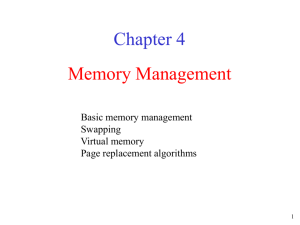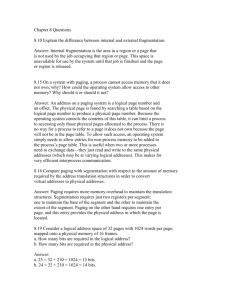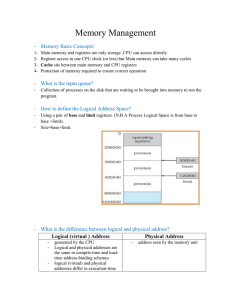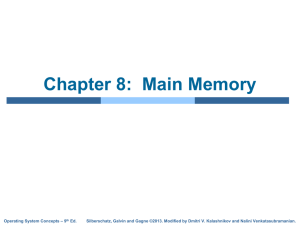- 8Semester
advertisement
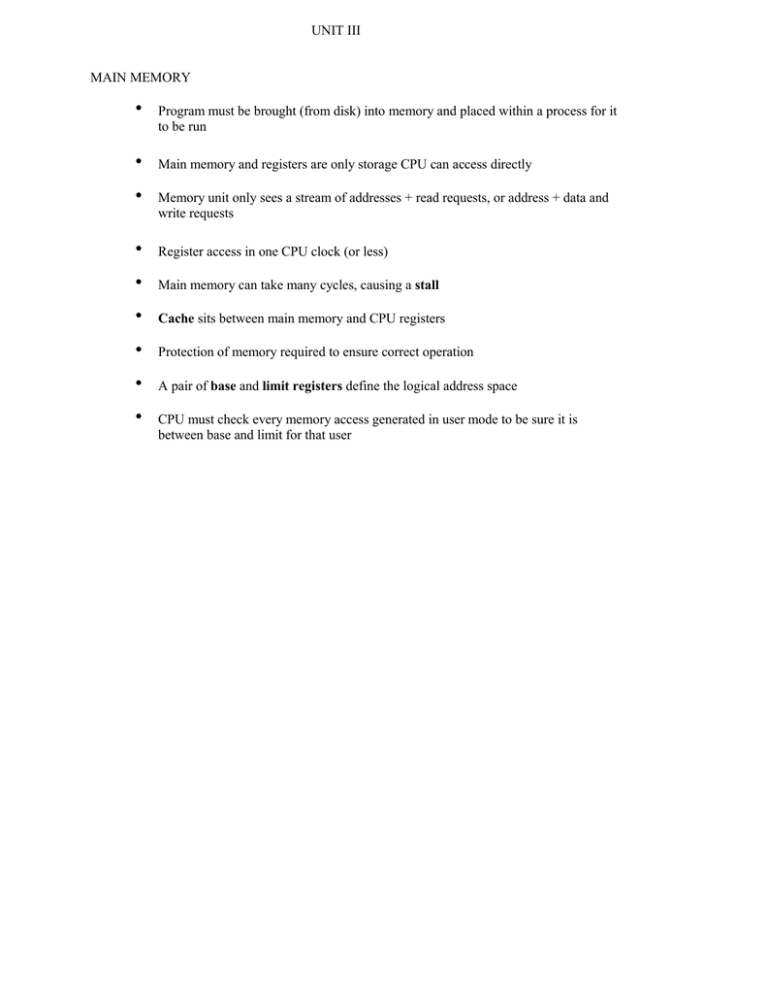
UNIT III MAIN MEMORY Program must be brought (from disk) into memory and placed within a process for it to be run Main memory and registers are only storage CPU can access directly Memory unit only sees a stream of addresses + read requests, or address + data and write requests Register access in one CPU clock (or less) Main memory can take many cycles, causing a stall Cache sits between main memory and CPU registers Protection of memory required to ensure correct operation A pair of base and limit registers define the logical address space CPU must check every memory access generated in user mode to be sure it is between base and limit for that user HARDWARE PROTECTION ADDRESS BINDING Programs on disk, ready to be brought into memory to execute form an input queue o Without support, must be loaded into address 0000 Inconvenient to have first user process physical address always at 0000 o How can it not be? Further, addresses represented in different ways at different stages of a program’s life o Source code addresses usually symbolic o Compiled code addresses bind to relocatable addresses i.e. ―14 bytes from beginning of this module‖ o Linker or loader will bind relocatable addresses to absolute addresses i.e. 74014 o Each binding maps one address space to another Address binding of instructions and data to memory addresses can happen at three different stages o Compile time: If memory location known a priori, absolute code can be generated; must recompile code if starting location changes o Load time: Must generate relocatable code if memory location is not known at compile time o Execution time: Binding delayed until run time if the process can be moved during its execution from one memory segment to another Need hardware support for address maps (e.g., base and limit registers) MULTISTEP PROCESSING LOGICAL VS PHYSICAL ADDRESS The concept of a logical address space that is bound to a separate physical address space is central to proper memory management o Logical address – generated by the CPU; also referred to as virtual address o Physical address – address seen by the memory unit Logical and physical addresses are the same in compile-time and load-time addressbinding schemes; logical (virtual) and physical addresses differ in execution-time address-binding scheme Logical address space is the set of all logical addresses generated by a program from generated by a programPhysical address space is the set of all physical addresses MMU Hardware device that at run time maps virtual to physical address Many methods possible, covered in the rest of this chapter To start, consider simple scheme where the value in the relocation register is added to every address generated by a user process at the time it is sent to memory o Base register now called relocation register o MS-DOS on Intel 80x86 used 4 relocation registers The user program deals with logical addresses; it never sees the real physical addresses o Execution-time binding occurs when reference is made to location in memory o Logical address bound to physical addresses DYNAMIC ALLOCATION Routine is not loaded until it is called Better memory-space utilization; unused routine is never loaded All routines kept on disk in relocatable load format Useful when large amounts of code are needed to handle infrequently occurring cases No special support from the operating system is required o Implemented through program design o OS can help by providing libraries to implement dynamic loading DYNAMIC LINKING Static linking – system libraries and program code combined by the loader into the binary program image Dynamic linking –linking postponed until execution time Small piece of code, stub, used to locate the appropriate memory-resident library routine Stub replaces itself with the address of the routine, and executes the routine Operating system checks if routine is in processes’ memory address o If not in address space, add to address space Dynamic linking is particularly useful for libraries System also known as shared libraries Consider applicability to patching system libraries o Versioning may be needed SWAPPING A process can be swapped temporarily out of memory to a backing store, and then brought back into memory for continued execution o Total physical memory space of processes can exceed physical memory Backing store – fast disk large enough to accommodate copies of all memory images for all users; must provide direct access to these memory images Roll out, roll in – swapping variant used for priority-based scheduling algorithms; lowerpriority process is swapped out so higher-priority process can be loaded and executed Major part of swap time is transfer time; total transfer time is directly proportional to the amount of memory swapped System maintains a ready queue of ready-to-run processes which have memory images on disk Does the swapped out process need to swap back in to same physical addresses? Depends on address binding method o Plus consider pending I/O to / from process memory space Modified versions of swapping are found on many systems (i.e., UNIX, Linux, and Windows) o Swapping normally disabled o Started if more than threshold amount of memory allocated o Disabled again once memory demand reduced below threshold CONTIGUOUS ALLOCATION Main memory must support both OS and user processes Limited resource, must allocate efficiently Contiguous allocation is one early method Main memory usually into two partitions: o Resident operating system, usually held in low memory with interrupt vector o User processes then held in high memory o Each process contained in single contiguous section of memory Relocation registers used to protect user processes from each other, and from changing operating-system code and data o Base register contains value of smallest physical address o Limit register contains range of logical addresses – each logical address must be less than the limit register o MMU maps logical address dynamically o Can then allow actions such as kernel code being transient and kernel changing size FRAGMENTATION External Fragmentation – total memory space exists to satisfy a request, but it is not contiguous Internal Fragmentation – allocated memory may be slightly larger than requested memory; this size difference is memory internal to a partition, but not being used First fit analysis reveals that given N blocks allocated, 0.5 N blocks lost to fragmentation o 1/3 may be unusable -> 50-percent rule Reduce external fragmentation by compaction o Shuffle memory contents to place all free memory together in one large block o Compaction is possible only if relocation is dynamic, and is done at execution time o I/O problem Latch job in memory while it is involved in I/O Do I/O only into OS buffers Now consider that backing store has same fragmentation problems SEGMENTATION Memory-management scheme that supports user view of memory A program is a collection of segments A segment is a logical unit such as: main program procedure function method object local variables, global variables common block stack symbol table arrays Logical address consists of a two tuple: <segment-number, offset>, Segment table – maps two-dimensional physical addresses; each table entry has: o base – contains the starting physical address where the segments reside in memory o limit – specifies the length of the segment o Segment-table base register (STBR) points to the segment table’s location in memory Segment-table length register (STLR) indicates number of segments used by a program; segment number s is legal if s < STLR Protection o With each entry in segment table associate: validation bit = 0 illegal segment read/write/execute privileges Protection bits associated with segments; code sharing occurs at segment level Since segments vary in length, memory allocation is a dynamic storage-allocation problem A segmentation example is shown in the following diagram PAGING Physical address space of a process can be noncontiguous; process is allocated physical memory whenever the latter is available o Avoids external fragmentation o Avoids problem of varying sized memory chunks Divide physical memory into fixed-sized blocks called frames o Size is power of 2, between 512 bytes and 16 Mbytes Divide logical memory into blocks of same size called pages Keep track of all free frames To run a program of size N pages, need to find N free frames and load program Set up a page table to translate logical to physical addresses Backing store likewise split into pages Still have Internal fragmentation Address generated by CPU is divided into: o Page number (p) – used as an index into a page table which contains base address of each page in physical memory o Page offset (d) – combined with base address to define the physical memory address that is sent to the memory unit o For given logical address space 2m and page size 2 n page number page offset p d m -n n PAGING STRUCTURE Calculating internal fragmentation o Page size = 2,048 bytes o Process size = 72,766 bytes o 35 pages + 1,086 bytes o Internal fragmentation of 2,048 - 1,086 = 962 bytes o Worst case fragmentation = 1 frame – 1 byte o On average fragmentation = 1 / 2 frame size o So small frame sizes desirable? o But each page table entry takes memory to track o Page sizes growing over time Solaris supports two page sizes – 8 KB and 4 MB Process view and physical memory now very different By implementation process can only access its own memory Page table is kept in main memory Page-table base register (PTBR) points to the page table Page-table length register (PTLR) indicates size of the page table In this scheme every data/instruction access requires two memory accesses o One for the page table and one for the data / instruction The two memory access problem can be solved by the use of a special fast-lookup hardware cache called associative memory or translation look-aside buffers (TLBs) Some TLBs store address-space identifiers (ASIDs) in each TLB entry – uniquely identifies each process to provide address-space protection for that process o Otherwise need to flush at every context switch TLBs typically small (64 to 1,024 entries) On a TLB miss, value is loaded into the TLB for faster access next time o Replacement policies must be considered o Some entries can be wired down for permanent fast access ASSOCIATIVE MEMORY Associative memory – parallel search Address translation (p, d) o If p is in associative register, get frame # out o Otherwise get frame # from page table in memory Page # Frame # PAGING WITH TLB Associative Lookup = time unit o Can be < 10% of memory access time Hit ratio = o Hit ratio – percentage of times that a page number is found in the associative registers; ratio related to number of associative registers Consider = 80%, = 20ns for TLB search, 100ns for memory access Effective Access Time (EAT) EAT = (1 + + (2 + – =2+– Consider = 80%, = 20ns for TLB search, 100ns for memory access o EAT = 0.80 x 100 + 0.20 x 200 = 120ns Consider more realistic hit ratio -> = 99%, = 20ns for TLB search, 100ns for memory access o EAT = 0.99 x 100 + 0.01 x 200 = 101ns MEMORY PROTECTION Memory protection implemented by associating protection bit with each frame to indicate if read-only or read-write access is allowed o Can also add more bits to indicate page execute-only, and so on Valid-invalid bit attached to each entry in the page table: o ―valid‖ indicates that the associated page is in the process’ logical address space, and is thus a legal page o ―invalid‖ indicates that the page is not in the process’ logical address space o Or use page-table length register (PTLR) Any violations result in a trap to the kernel VALID OR INVALID BIT IN PAGE TABLE STRUCTURE OF THE PAGE TABLE Memory structures for paging can get huge using straight-forward methods o Consider a 32-bit logical address space as on modern computers o Page size of 4 KB (212) o Page table would have 1 million entries (232 / 212) o If each entry is 4 bytes -> 4 MB of physical address space / memory for page table alone That amount of memory used to cost a lot Don’t want to allocate that contiguously in main memory Hierarchical Paging Hashed Page Tables Inverted Page Tables TWO LEVEL PAGE SCHEME A logical address (on 32-bit machine with 1K page size) is divided into: o a page number consisting of 22 bits o a page offset consisting of 10 bits o Since the page table is paged, the page number is further divided into: o a 12-bit page number o a 10-bit page offset o Thus, a logical address is as follows: where p1 is an index into the outer page table, and p2 is the displacement within the page of the inner page table Known as forward-mapped page table ADDRESS TRANSLATION SCHEME 64 BIT ARCHITECTURE Even two-level paging scheme not sufficient If page size is 4 KB (212) o Then page table has 252 entries o If two level scheme, inner page tables could be 210 4-byte entries o Address would look like o Outer page table has 242 entries or 244 bytes o One solution is to add a 2nd outer page table o But in the following example the 2nd outer page table is still 234 bytes in size And possibly 4 memory access to get to one physical memory location INTEL 32 BIT ARCHITECTURE VIRTUAL MEMORY VIRTUAL ADDRESS SPACE Usually design logical address space for stack to start at Max logical address and grow ―down‖ while heap grows ―up‖ o Maximizes address space use o Unused address space between the two is hole No physical memory needed until heap or stack grows to a given new page Enables sparse address spaces with holes left for growth, dynamically linked libraries, etc System libraries shared via mapping into virtual address space Shared memory by mapping pages read-write into virtual address space Pages can be shared during fork(), speeding process creation SHARED LIBRARY USING VIRTUAL MEMORY DEMAND PAGING Could bring entire process into memory at load time Or bring a page into memory only when it is needed o Less I/O needed, no unnecessary I/O o Less memory needed o Faster response o More users Similar to paging system with swapping (diagram on right) Page is needed reference to it o invalid reference abort o not-in-memory bring to memory Lazy swapper – never swaps a page into memory unless page will be needed o Swapper that deals with pages is a pager With swapping, pager guesses which pages will be used before swapping out again Instead, pager brings in only those pages into memory How to determine that set of pages? o Need new MMU functionality to implement demand paging If pages needed are already memory resident o No difference from non demand-paging If page needed and not memory resident o Need to detect and load the page into memory from storage Without changing program behavior Without programmer needing to change code VALID OR INVALID BIT With each page table entry a valid–invalid bit is associated (v in-memory – memory resident, i not-in-memory) Initially valid–invalid bit is set to i on all entries Example of a page table snapshot: During MMU address translation, if valid–invalid bit in page table entry is i page fault If there is a reference to a page, first reference to that page will trap to operating system: PAGE FAULT 1. Operating system looks at another table to decide: l Invalid reference abort l Just not in memory 2. Find free frame 3. Swap page into frame via scheduled disk operation 4. Reset tables to indicate page now in memory Set validation bit = v 5. Restart the instruction that caused the page fault 6. Extreme case – start process with no pages in memory l OS sets instruction pointer to first instruction of process, non-memory-resident -> page fault l And for every other process pages on first access l Pure demand paging 7. Actually, a given instruction could access multiple pages -> multiple page faults l Consider fetch and decode of instruction which adds 2 numbers from memory and stores result back to memory l Pain decreased because of locality of reference 8. Hardware support needed for demand paging l Page table with valid / invalid bit l Secondary memory (swap device with swap space) l Instruction restart INSTRUCTION RESTART Consider an instruction that could access several different locations block move auto increment/decrement location Restart the whole operation? What if source and destination overlap? PERFORMANCE n Stages in Demand Paging (worse case) 1. Trap to the operating system 2. Save the user registers and process state 3. Determine that the interrupt was a page fault 4. Check that the page reference was legal and determine the location of the page on the disk 5. Issue a read from the disk to a free frame: 1. Wait in a queue for this device until the read request is serviced 2. Wait for the device seek and/or latency time 3. Begin the transfer of the page to a free frame 6. While waiting, allocate the CPU to some other user 7. Receive an interrupt from the disk I/O subsystem (I/O completed) 8. Save the registers and process state for the other user 9. Determine that the interrupt was from the disk 10. Correct the page table and other tables to show page is now in memory 11. Wait for the CPU to be allocated to this process again 12. Restore the user registers, process state, and new page table, and then resume the interrupted instruction PAGE REPLACEMENT Prevent over-allocation of memory by modifying page-fault service routine to include page replacement Use modify (dirty) bit to reduce overhead of page transfers – only modified pages are written to disk NEED Page replacement completes separation between logical memory and physical memory – large virtual memory can be provided on a smaller physical memory BASIC PAGE REPLACEMENT 1. Find the location of the desired page on disk 2. Find a free frame: - If there is a free frame, use it - If there is no free frame, use a page replacement algorithm to select a victim frame - Write victim frame to disk if dirty 3. Bring the desired page into the (newly) free frame; update the page and frame tables 4. Continue the process by restarting the instruction that caused the trap ALGORITHMS Frame-allocation algorithm determines o How many frames to give each process o Which frames to replace Page-replacement algorithm o Want lowest page-fault rate on both first access and re-access Evaluate algorithm by running it on a particular string of memory references (reference string) and computing the number of page faults on that string o String is just page numbers, not full addresses o Repeated access to the same page does not cause a page fault o Results depend on number of frames available In all our examples, the reference string of referenced page numbers is FIFO 7,0,1,2,0,3,0,4,2,3,0,3,0,3,2,1,2,0,1,7,0,1 OPTIMAL ALGORITHM LRU Keep a pool of free frames, always o Then frame available when needed, not found at fault time o Read page into free frame and select victim to evict and add to free pool o When convenient, evict victim Possibly, keep list of modified pages o When backing store otherwise idle, write pages there and set to non-dirty Possibly, keep free frame contents intact and note what is in them o If referenced again before reused, no need to load contents again from disk o Generally useful to reduce penalty if wrong victim frame selected Each process needs minimum number of frames Example: IBM 370 – 6 pages to handle SS MOVE instruction: o instruction is 6 bytes, might span 2 pages o 2 pages to handle from o 2 pages to handle to Maximum of course is total frames in the system Two major allocation schemes o fixed allocation o priority allocation Many variations THRASHING If a process does not have ―enough‖ pages, the page-fault rate is very high o Page fault to get page o Replace existing frame o But quickly need replaced frame back o This leads to: Low CPU utilization Operating system thinking that it needs to increase the degree of multiprogramming Another process added to the system Thrashing a process is busy swapping pages in and out Why does demand paging work? Locality model Process migrates from one locality to another Localities may overlap Why does thrashing occur? size of locality > total memory size Limit effects by using local or priority page replacement




